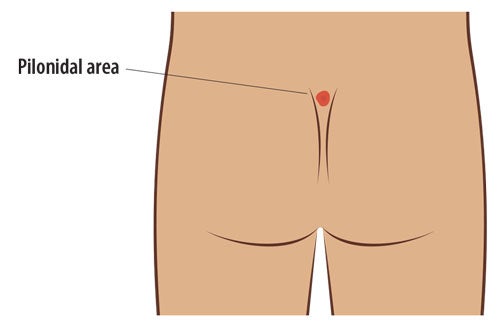Appointment
(919) 350-8797Schedule an Appointment - (919) 698-1109
ScheduleRefer a Patient
Refer (PDF)What is Pilonidal Disease?
Pilonidal disease (often referred to as a Pilonidal cyst) is a chronic skin and subcutaneous fat infection in the crease of the buttocks typically occurring in patients age 14 to 26.
The condition is often the result of hairs that invade the skin in the cleft (crease of the buttocks) and become infected.
Most patients that have a pilonidal cyst experience large, painful areas that are tender to the touch with openings draining clear, cloudy or bloody discharge. Redness and tenderness with foul smelling pus (discharge), with possible fever, are indications of an abscess formation.
While pilonidal disease in children is relatively common, many don’t realize the problem has an incredibly high recurrence rate if not treated properly. Our pediatric surgeons promote the definitive treatment of pilonidal disease with excision and flap coverage, if possible. We are experienced with the use of rhomboid (Limberg) flap as well as the cleft lift advancement (Bascom) flap.
Read more about what to expect before and after pilonidal disease surgery in our patient handbook.
Treatment: Cleft Lift Procedure
The first course of action for patients is typically a round of antibiotics along with draining of the abscess. In most cases, however, recurrence is likely without definitive surgical treatment.
The WakeMed pediatric surgeons are pleased to offer the cleft lift procedure, an outpatient surgical procedure that is intended to cure pilonidal disease. Performed under general anesthesia, the procedure takes about an hour and patients are discharge home the same day with minimal discomfort and can return to full activity, including athletics, in 1 to 2 days.
The cleft lift procedure differs from other procedures in that it only removes scarred skin and minimal underlying tissue, putting the incision sufficiently to the side so it can heal well. Other flap procedures often result in disfiguring scars and fail to sufficiently shallow or re-contour the cleft to prevent recurrence.

Benefits
- Closed wound with no packing needed
- Faster return to normal activity (1 to 2 days)
- No scarring/disfiguring
- Minimal pain
- Lowest recurrence rate among all flap procedures (between 1 and 5%)